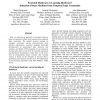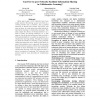413 search results - page 35 / 83 » IT alignment: what have we learned |
ETS
2002
IEEE
13 years 7 months ago
2002
IEEE
This paper describes a research project, which seeks to showcase the experience base of practitioners with technology-enhanced teaching and learning. A particular focus of this in...
ICRA
1999
IEEE
13 years 12 months ago
1999
IEEE
Current manufacturing methods for robotic-controlled assembly rely on accurate positioning to ensure task completion, often through the use of special xtures and precise calibrati...
EH
1999
IEEE
1999
IEEE
Evolvable Hardware or Learning Hardware? Induction of State Machines from Temporal Logic Constraints
14 years 3 hour ago
Here we advocate an approach to learning hardware based on induction of finite state machines from temporal logic constraints. The method involves training on examples, constraint...
HICSS
2008
IEEE
14 years 2 months ago
2008
IEEE
Many peer-to-peer (P2P) networks have been widely used for file sharing. A peer acts both as a content provider and a consumer, and is granted autonomy to decide what content, wit...
CORR
2002
Springer
13 years 7 months ago
2002
Springer
A large body of research in machine learning is concerned with supervised learning from examples. The examples are typically represented as vectors in a multi-dimensional feature ...


